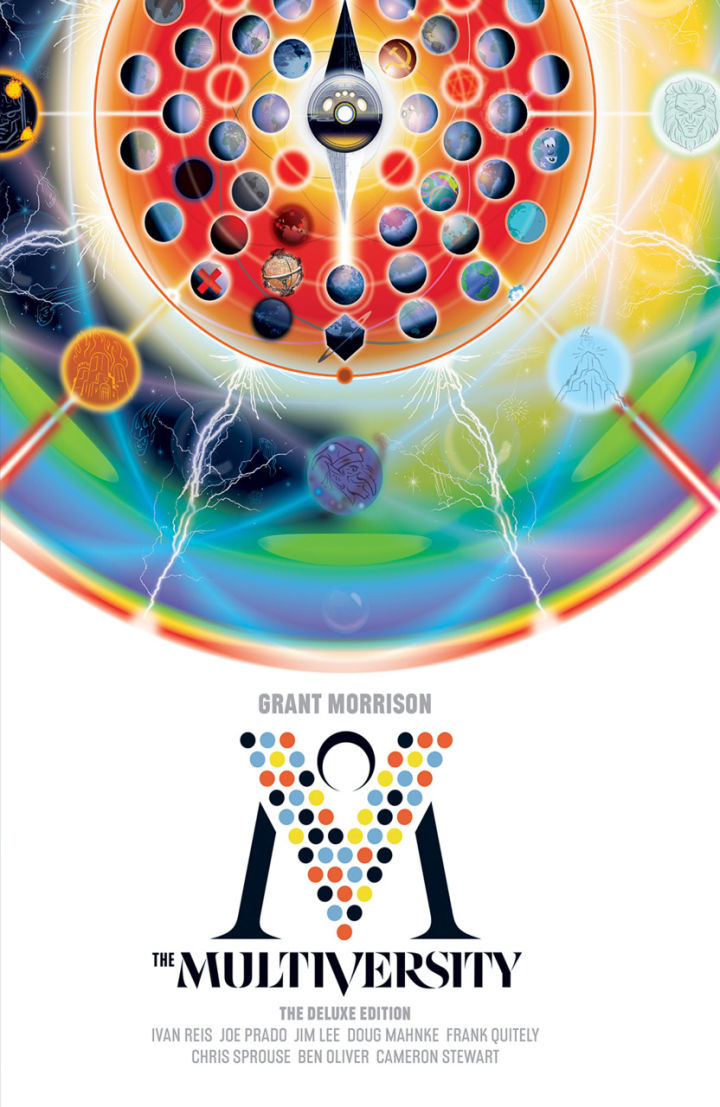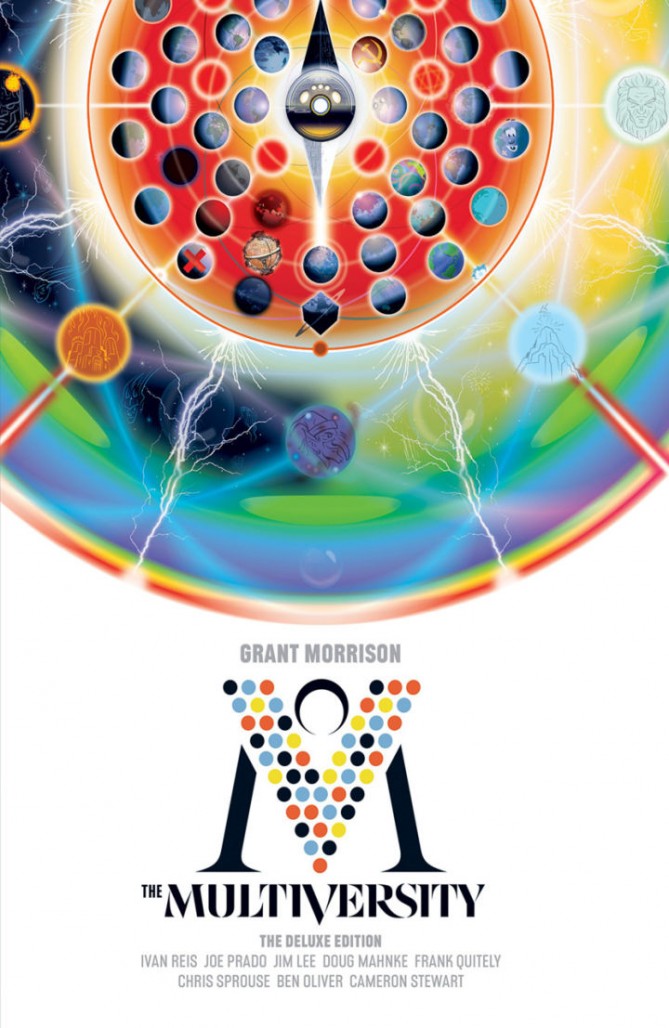Writer: Grant Morrison
Artists: Ivan Reis, Chris Sprouse, Ben Oliver, Frank Quitely, Cameron Stewart, Joe Prado, Jim Lee, Doug Mahnke, and a host of others.
Price: $49.99 (U.S.)
The biggest adventure in DC’s history is here! Join visionary writer Grant Morrison, today’s most talented artists, and a cast of unforgettable heroes from 52 alternative Earths of the DC Multiverse! Prepare to meet the Vampire League of Earth-43, the Justice Riders of Earth-18, Superdemon, Doc Fate, the super-sons of Superman and Batman, the rampaging Retaliators of Earth-8, the Atomic Knights of Justice, Dino-Cop, Sister Miracle, Lady Quark, and the latest, greatest Super Hero of Earth-Prime: YOU! This deluxe edition hardcover collects all nine MULTIVERSITY issues, plus the indispensible GUIDEBOOK issue!
One of the biggest critical smashes of last year was Grant Morrison’s uproarious adventure through the known worlds of the DC multiverse: The Multiversity. Morrison’s set of stand-alone issues, all of which represented a different earth (Nazi Superman! Pulp Heroes! Charlton! The Marvel Family! etc) in the vast DC cosmology, bookended by two stories that tell of a destructive force that threatens them all, including the reader, was a big hit with fans and critics. It also landed Morrison his latest set of Eisner nominations (for Best Writer, Best Limited Series, and Best Single Issue respectively, along with Best Penciller/Inker for Frank Quitely’s efforts on much lauded Pax Americana).
Today sees the release of the collected edition of said series, and with that comes the usual press. Morrison himself is revisiting the series with a few outlets like IGN and The Washington Post, ruminating both on what’s within this solidly constructed tome and what the future holds for the concept (get ready for a Flash-centric Multiversity Too story someday soon…hopefully).
Focusing on the matter at hand, what exactly do you get if you pick up this admittedly very well designed package?
- All 9 issues of the series, including the Guidebook, arranged in their release order. While there wasn’t really a set sequential order in the stand-alone issues (barring Thunderworld leading into the Guidebook), there is a nice flow between issues, particularly with Pax Americana somewhat standing as the midway point between the 8 core issues of the run. Given that this issue is focused on the number 8 so heavily, from its thematic material to its panel layouts, to its ability to be read forwards and backwards, this is fitting. Though this arrangement also highlights how much the Guidebook stops a reader in their tracks in terms of narrative flow. It’s a fascinating info-dump, and a lot of fun for the person who, like me, enjoys breaking down the intracacies of Morrison and Rian Hughes’ Multiversal Map. Yet, after the high-octane energy of Pax and Thunderworld, looking at 51 separate entries for the various permutations of the Justice League that exist feels like brake pumping.
- All the variants released during the series’ run, including some of the publisher’s bigger name artists tackling some of the DC-Earths that either make cameo appearances in the series or don’t appear at all (who doesn’t want to see Duncan Rouleau illustrate Prez and Sunshine Superman or Mike Allred riff on Cosmic Odyssey?). There are also a number of variants that focus on other multiversal events in DC’s history, the various Crises and so on. Lastly, Morrison himself contributes sketch covers.
- The final section includes character sketches and a few page breakdowns from Morrison and how they were translated by the murderer’s row of artists that participated in the project. Also included are character designs that originated with the artists in question, such as Cameron Stewart’s take on the Marvel Family and their nemeses.
- In the back end of the book, for those who are very interested in Morrison’s working process on the map, there is a small set of two images that slightly detail the orreries that exist between the various sets of parallel Earths within the concordance. Unfortunately, there’s not a ton of context provided here as to what various terms actually mean, though having names for certain sets of worlds makes for interesting trivia. Additionally, inside the book jacket is the entire map as well, in a form that’s a much more visible than the map in the Guidebook that unfortunately falls prey to gutter loss in its middle section.
Is it worth buying? If you’ve never read The Multiversity, absolutely. I’d argue it’s one of Morrison’s strongest recent works and could very well be a perennial in the same mold and fashion as All Star Superman, particularly if it ever spawns any stand-alone sequels.
If you already own the issues, the 50 dollar price tag (though about 45% cheaper currently on Amazon) may prove too big a hurdle, especially as the supplemental material isn’t necessarily what I’d call essential. But, if you’re like me, and you loved the series as though your life depended on it, and want a more portable version that you can share with your comic-minded and curious friends, go forth and purchase!









I don’t think this is anywhere even remotely close to All-Star Superman. It was a disjointed, muddled mess. People aren’t treating Final Crisis as one for the ages in the same way they are some of Morrison’s other work, and this will follow that same path.
How’s the binding on this? Typical DC, or the quality sewn binding that occasionally gets used, as in Wednesday Comics? Approximately how much art would you estimate disappears from a double-page spread? Is the map printed across two pages, and if so, is the center part at all legible?
Ralf:
One man’s trash, though I say that as someone who thinks Flex Mentallo is the superior Morrison/Quitely collaboration.
Carl:
Typical DC glued binding. I’d say in most cases it’s not a big problem for my eyes, though you probably lose about 5% of the art on the spreads. The center part of the map is completely obscured though, as it’s printed across both pages. I’m guessing DC realized that when they reprinted the map inside the dust jacket.
Meh, I’ll wait for the absolute edition. I’d still rate this above ASS. That comic while good, is nowhere near as daring as Multiversity and the things it tried to do.
On another front, Ben Oliver stuck out like a sore thumb out of all the artists’. I’m sure a better choice could have been used because his style doesn’t mesh well at all when you compare it with the others.
Off-topic, but atleast he’s better than Esad “omg face” Ribic who is failing hard at Secret Wars. First the time art has disappointed me on an event comic.
Comments are closed.